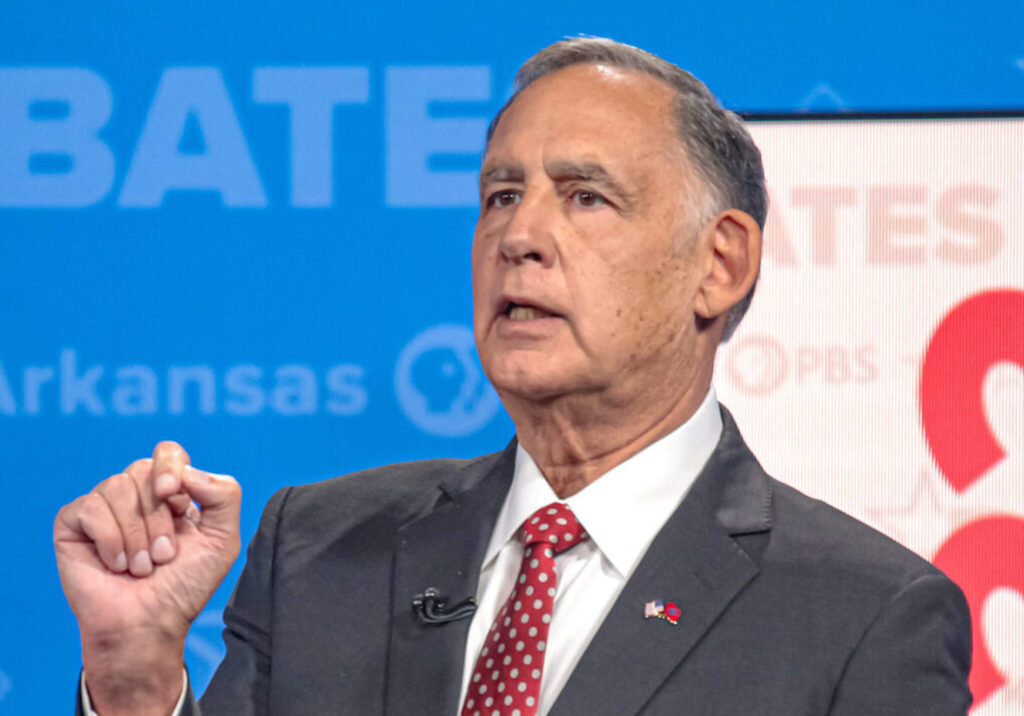Republican U.S. Sen. John Boozman of Arkansas on Tuesday, June 11, 2024, met with reporters to discuss the GOP farm bill. (Photo by John Sykes/Arkansas Advocate)
WASHINGTON — Republicans on the U.S. Senate Committee on Agriculture, Nutrition, and Forestry on Tuesday released their framework for a new five-year farm bill that will set the policy and funding levels for key food, agriculture and conservation programs.
The top Republican on the committee, Arkansas Sen. John Boozman, laid out GOP priorities with reporters during a Tuesday morning briefing prior to publication of the framework.
Those priorities include an increase in reference prices for all covered commodities; increased spending for conservation programs by pulling funds from climate legislation passed in 2022; “cost-neutral” updates to the formula that calculates benefits for the Supplemental Nutrition Assistance Program, known as SNAP; increased crop insurance levels; and reporting requirements for foreign purchase and ownership of farmland.
“Hopefully, we can take all of these together and build on that so we can actually get a farm bill passed,” Boozman said.
The GOP measure also doubles funding for land grant universities for research on topics such as fertilizer application, pesticides and labor, Boozman said.
Boozman said the investment in research will help with “getting agriculture into this century.”
Boozman said the framework will also boost crop insurance by increasing support for the Supplemental Coverage Option to 80% and the coverage level to 90% for more than 55 specialty and row crops.
He added that the Senate’s framework is similar to the one House Republicans put forth.
“Following on the House Committee on Agriculture’s bipartisan passage of (a) farmer-focused farm bill, we are putting forth a framework that exhibits a shared common ground with our Democrat counterparts on several key priorities and offers a path forward in the places where we differ,” Boozman said.
House action
The House Committee on Agriculture passed its version of the farm bill out of committee in late May, and while four Democrats joined Republicans in approving the bill, nearly two dozen Democrats were against it.
The House version of the farm bill is expected to cost $1.5 trillion over the next 10 years, but there is currently no cost estimate for the Senate GOP version. There is also no bill text for the Senate version.
The current farm bill expires on Sept. 30, and if Congress doesn’t pass a new one, an extension would be needed of policies enacted under the 2018 farm bill.
Boozman said he hopes Congress doesn’t have to pass an extension, but if so, he expects to get the farm bill done during the lame-duck session after the November elections.
Like the House GOP version, the Senate legislation would divert funds from climate-related legislation passed in 2022 for conservation projects that would remove some climate-smart guardrails, which has drawn objections from Democrats.
Boozman said taking off the guardrails would “make it more useful.”
Nutrition programs
The Senate Republican farm bill framework would not make any changes to benefits and eligibility for SNAP, but it curtails an update tool used by the Thrifty Food Plan.
“The Republican framework restores Congress’ constitutional spending authority by returning to a cost-neutral and transparent process for future five-year reevaluations of the (Thrifty Food Plan) based on the most up-to-date consumption data and dietary guidance, all while ensuring an annual inflationary adjustment,” according to the framework.
In 2018, the farm bill allowed the U.S. Department of Agriculture to reevaluate the Thrifty Food plan and in 2021 the agency updated it to reflect the cost of living, which led to a 21% increase in SNAP benefits. About 12.8% of U.S. households were food-insecure in 2022, according to USDA. More than 41 million people use SNAP benefits.
The Senate’s version reverts to a “cost-neutral” model, Boozman said, which is similar to the House Republican version. Democrats have already opposed those changes.
The Democratic chair of the Senate committee, Sen. Debbie Stabenow of Michigan, released a section-by-section version of the Democrats’ farm bill in early May. That version would boost eligibility for SNAP benefits, but there is no legislative text for that bill either.
Foreign ownership of farmland
Limiting foreign ownership of U.S. farmland has garnered bipartisan support in Congress, as states have passed their own laws on the issue.
Agriculture Secretary Tom Vilsack has said the biggest foreign land ownership comes from Canada, the Netherlands and the United Kingdom, but there is concern in Congress about ownership by Russia, China, Iran and North Korea — which own less than 400,000 acres of land.
Lawmakers are pushing for federal reporting requirements in the Senate GOP farm bill under Title XII, the miscellaneous section.
“This modernization will help ensure compliance with reporting requirements and provides a clearer picture of the scope and scale of the issues foreign ownership of U.S. farmland poses to our country,” according to the framework.
The post U.S. Senate Republicans outline their farm bill framework appeared first on Kentucky Lantern.

